10 Chatbot Best Practices for Successful Automation
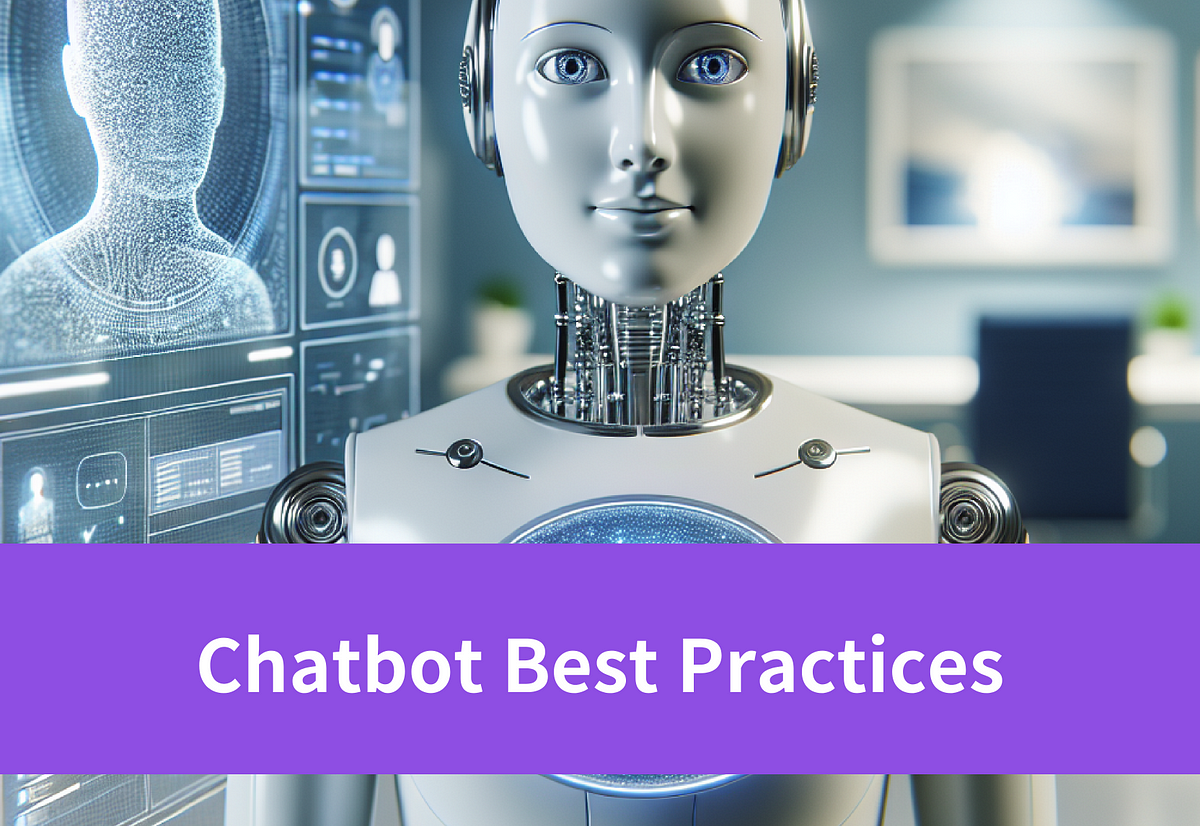
Elevate your automation game with these chatbot best practices. Discover the secrets to successful chatbot implementation on our blog.
Key Highlights
- By using AI, chatbots can give fast and spot-on answers. This cuts down on waiting time for responses and makes users more involved.
- With smart automation, chatbots can make dealing with customers smoother and improve their experience.
- If you get the design and features of your chatbot just right, you’ll tap into what it can do to help out.
- Listening to what users say they want or need from your bot — and looking closely at performance data — can guide improvements that hit the mark with customer expectations.
- Giving easy-to-follow directions while keeping things friendly will clear up any confusion and add a nice touch to your bot’s character.
- Novita AI is an AI API platform featuring various LLMs. With LLM API services provided by Novita AI, you can produce cost-effectively.
Introduction
In today’s digital world, chatbots are a key player in customer service. These AI helpers are changing how companies talk to their customers by offering quick help, tailored suggestions, and smart solutions to problems. But it’s important to remember that not every chatbot is the same. For automation to work well, there are some best practices you need to follow. Doing so will ensure users have a great experience, keep them engaged better, and get the most out of chatbot technology. Let's dive into this blog!
Understanding Chatbot
Chatbots are like smart computer programs that can chat with you. They’re made to mimic how humans talk and can automatically answer your questions. With the help of something called natural language processing, these clever bots get better at figuring out what you’re saying. When creating a chatbot, developers train it using lots of data so it gets good at responding accurately. The main aim is to make a chatbot that’s easy for people to use and makes talking to customers smoother and more enjoyable.
What is A Chatbot?
A chatbot is a software or computer program that simulates human conversation through text or voice interactions. Businesses use chatbot virtual assistants to handle tasks efficiently, reducing costs and providing 24/7 customer service. Chatbots vary from basic scripted responses to advanced AI models that can perform complex tasks. With the help of natural language processing, it can figure out what you’re asking and give you answers or guidance just like a human would. They learn lots of information about products, services, and more.
Why Do Chatbot Best Practices Matter?
Creating effective chatbots involves implementing the best methods for automation. Following chatbot best practices leads to higher customer satisfaction and loyalty. By prioritizing user satisfaction and consistently refining the chatbot based on feedback and data analysis, businesses can fully leverage the benefits of chatbot technology and drive business growth.
How Does LLM Relate to Chatbot?
NLP techniques like Large Language Models (LLM) enhance chatbots’ conversational abilities, enabling them to understand and generate human-like responses. By leveraging LLM technology, chatbots can provide more relevant, accurate, and engaging interactions with users. This advanced language processing allows chatbots to adapt to different communication styles, leading to more personalized conversations and successful implementations.
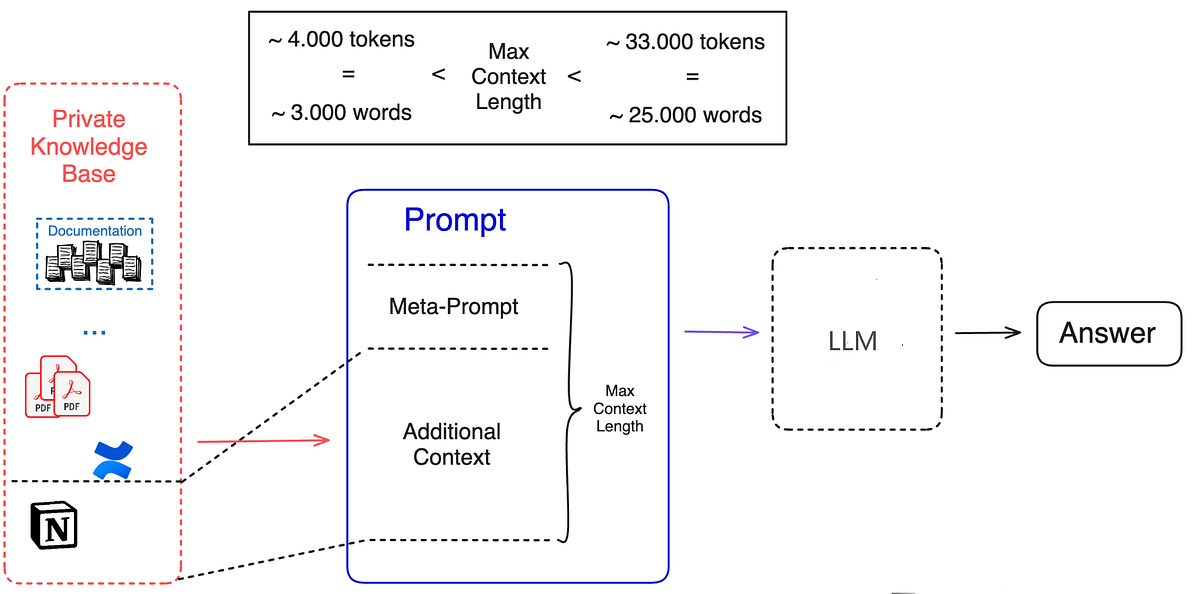
Key Features of an Effective Chatbot
To build an effective chatbot, focus on user-friendly features like suggested responses and simple language. Adapt based on user feedback and data insights, improving the user experience and query handling efficiency.
Suggested Responses
Having suggested responses is essential for a chatbot’s functionality. Providing users with predefined choices streamlines communication, leading them to answers faster. This feature enhances user experience by tailoring responses to various scenarios, ensuring efficient assistance.
Clear Language
When chatting with users via your chatbot, keep it clear and simple. Avoid complex language that can confuse and frustrate users. Using straightforward language helps everyone understand and stay engaged in the conversation.
Evolving with User Feedback
To improve a chatbot’s performance, companies should focus on enhancing user feedback and utilizing data analytics. By listening to users, analyzing their data, and staying updated on customer needs, businesses can optimize the chatbot’s functionality effectively.
Quick Reply
Adding quick reply options improves chatbot usability for users. Benefits include faster response times, easier engagement in the welcome message, and smoother conversations leading to increased satisfaction.
Cost Savings
Automating routine tasks enables companies to lower operational expenses and distribute resources more efficiently.
10 Chatbot Best Practices
Here are chatbot best practices for you to release the full potential of chatbots.
1. Identify Challenges
When designing a chatbot, start by identifying the issues you want to address. List and rank them by urgency to clarify your chatbot’s purpose in solving these problems.
2. Determine Target Audience
Understanding your user base is key to a successful AI chatbot. Tailoring its functions and responses to their needs is crucial for resonant interactions.
3. Choose the Right Platform
You need to choose the right home for your chatbot. Ideally, you’ll want to choose a channel that your customers already use. They don’t want to be forced to download yet another application to communicate with a brand.
4. Select an Appropriate Provider
After listing the goals and communication channels for your chatbot, the next step is to select the technology or solution provider for its use. There are different types of LLMs for building chatbots. Novita AI offers a great solution Llama 3.1 70B Instruct, which uses NLP technology coupled with symbolic AI. For optimal results with your AI-powered chatbot, consider this winning combination when choosing your technology provider to ensure seamless integration into your application.
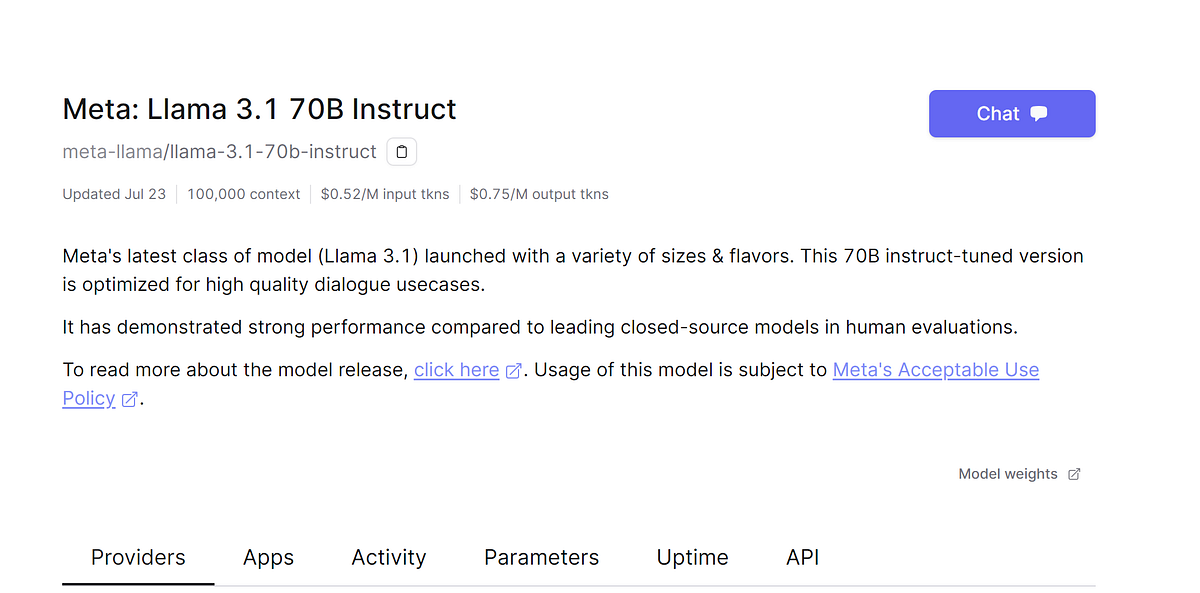

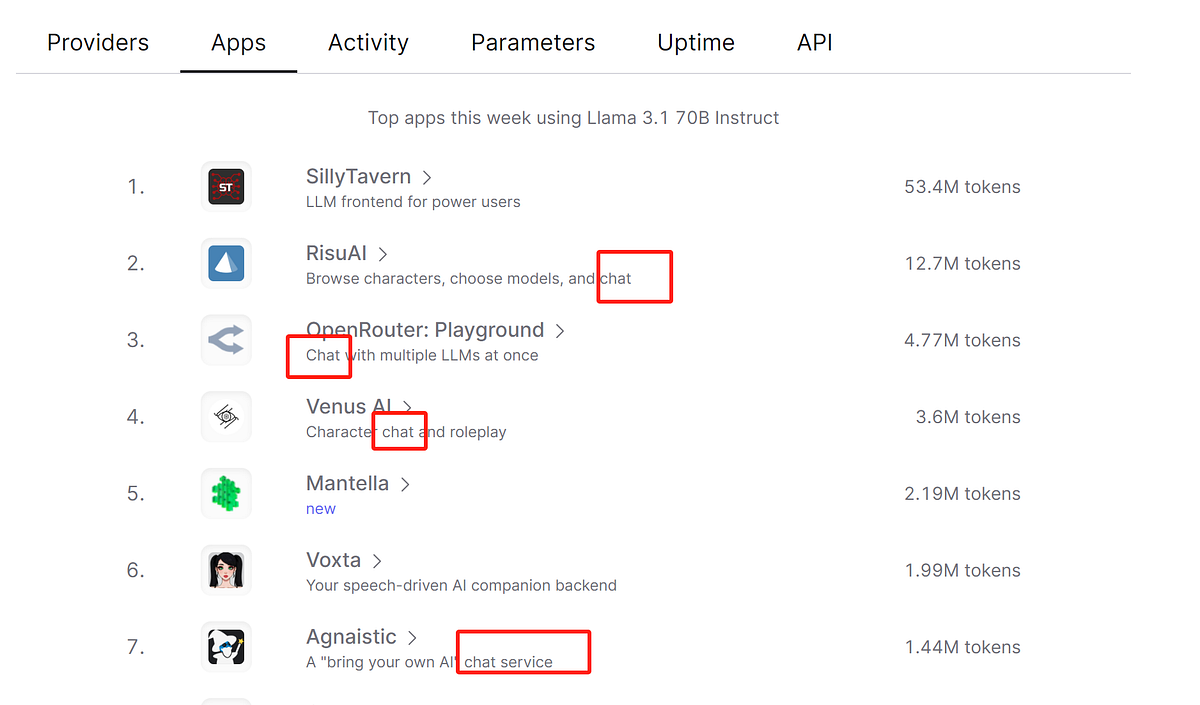
5. Develop a Chatbot Personality
Chatbots don’t have to be boring automatons. Give your bot personality to connect with customers. Customers appreciate a chatbot with humour and personality. You can do the following steps.
- Give your Chatbot a name: a human-like name such as Jessica, Linda, or Tom, instead of an AI name “customer service chatbot”.
- Define the age: Now, assign a date of birth to your chatbot based on its designated role and gender.
- Define gender: Although there are transgender chatbots, in general cases, you need to choose between male or female.
- Complete the role: Most chatbots are created to serve business goals. Whether it’s for education, entertainment, or any other purpose, start by defining a role for your chatbot within your organization. You can also add a welcoming personality.
6. Train Chatbot
Take the time to train your chatbot before deploying it. Treat it like a new employee — teach it context and provide diverse examples of responses to different conversation styles. Context is key for your chatbot to adapt effectively.
7. Boost Quick Replies
Chatbots prioritize speed and efficiency. Providing pre-written response options enables customers to get quick answers with just a tap, ensuring instant gratification.
8. Ready for Fallback Messages
No matter how good your chatbot is, it has limitations. Plan for a fallback message in case the bot gets confused by a user’s inquiry. This message helps the bot recover the conversation when it can’t provide an answer from its knowledge base.
9. Optimize the User Experience
To overcome these limitations, you need a technology that can detect your users’ emotions by analyzing their tone and the type of language they use. Gemma-2–9b-it provided by Novita AI is a good choice to analyze customer‘s emotions.
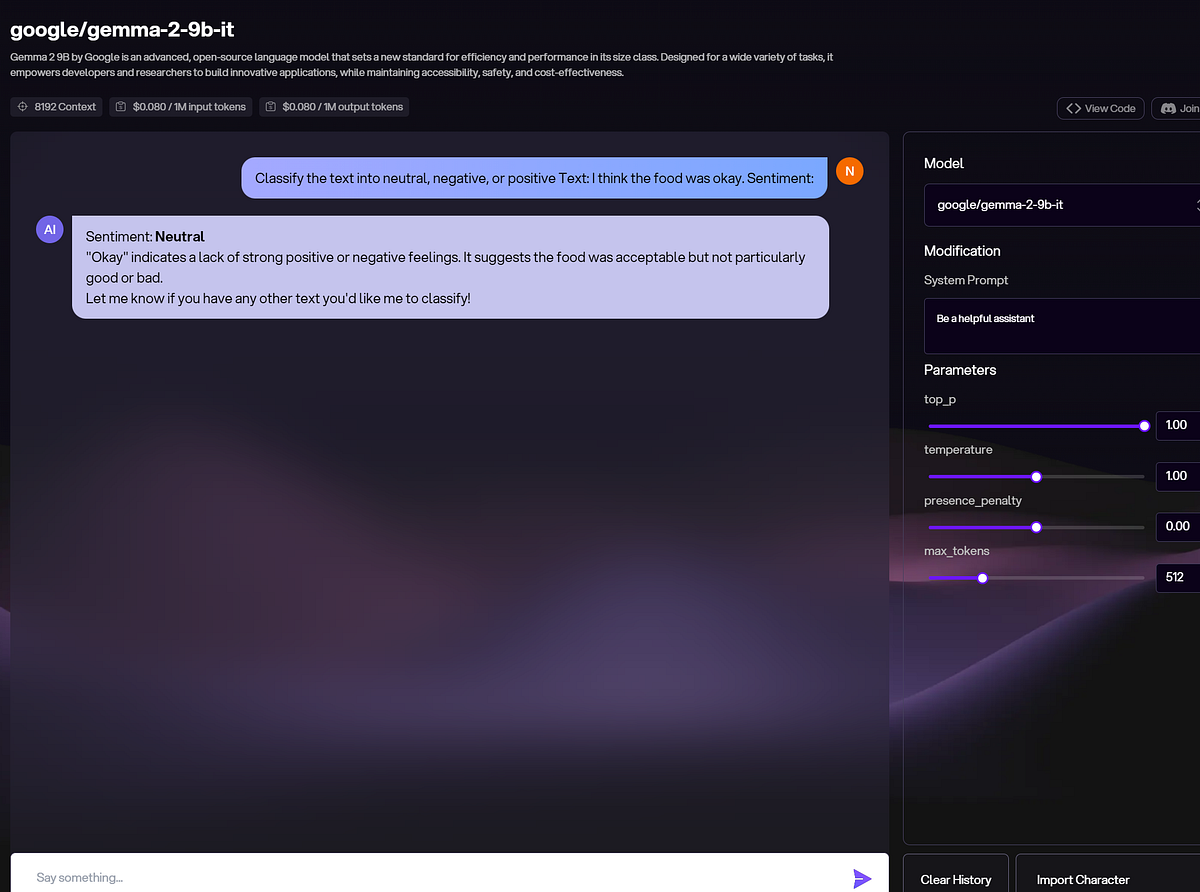
10. Test Regularly and Fine-tune
Test your chatbot before releasing a new chatbot and continue monitoring its performance post-launch. Many companies overlook this crucial step and neglect their chatbots once developed. Make sure your chatbot provides friendly responses consistently.
Getting Started with Novita AI
As mentioned before, Novita AI, a user-friendly and cost-effective platform designed to cater to various AI API requirements, is prepared to offer LLM API service. Here’s a guide to effectively using it.
Step-by-step Guide to Using LLM API with Novita AI
- Step 1: Visit Novita AI and create an account.

- Step 2: Navigate to “LLM API Key” to acquire an API key from Novita AI.
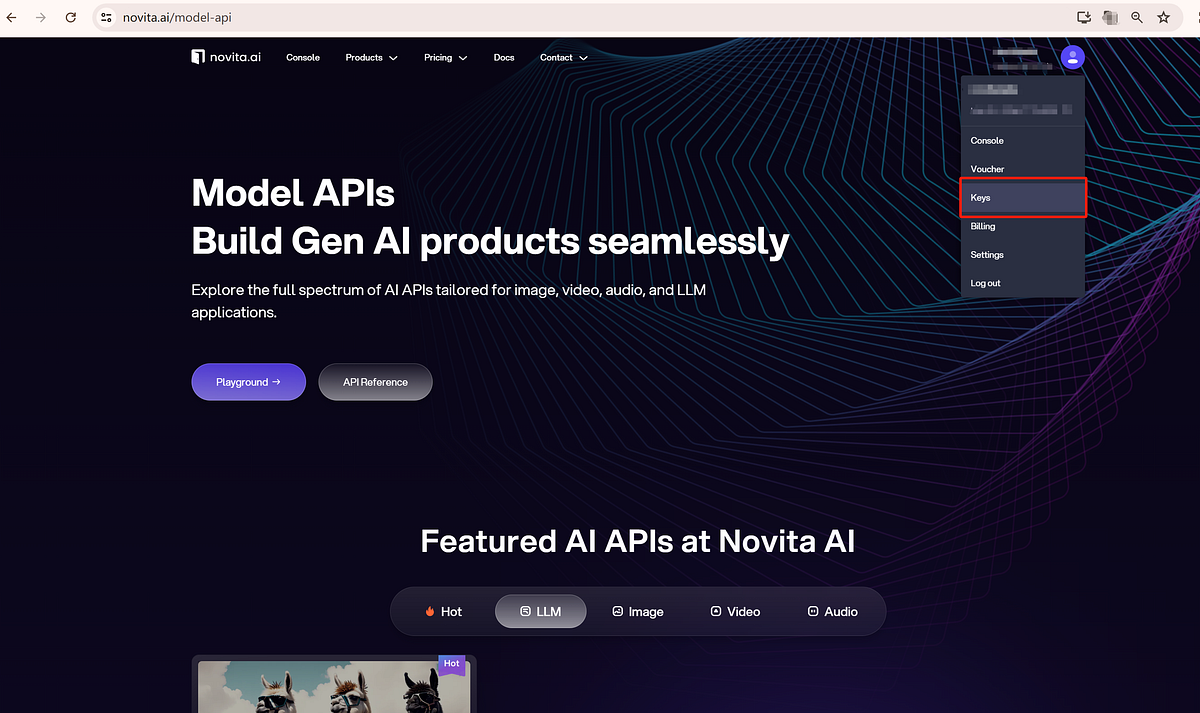
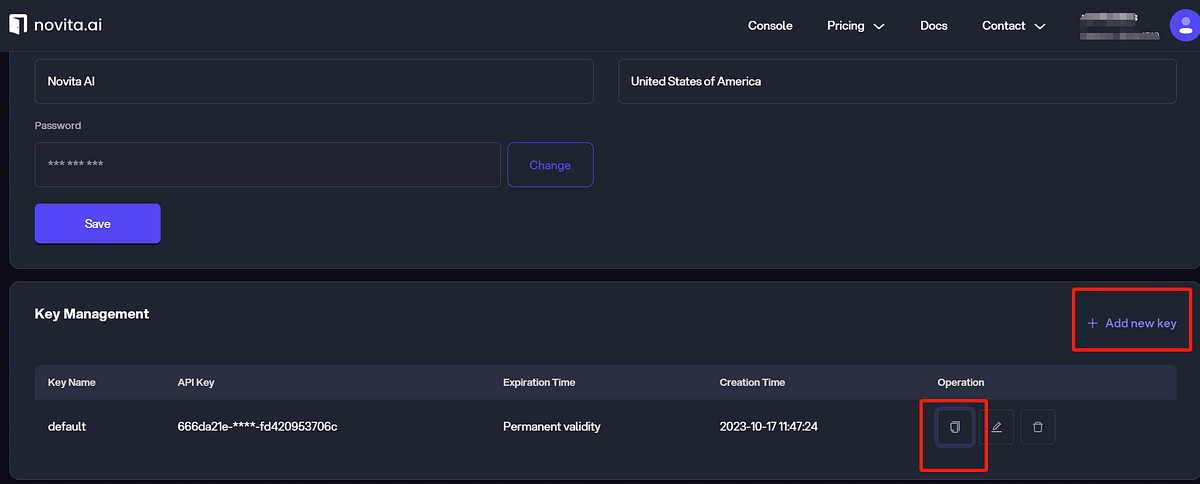
- Step 3: After receiving your key, click on Model API under the “Products” tab. Novita AI offers “Featured AI APIs.” Look for the LLM service in the LLM column or the Hot Column.
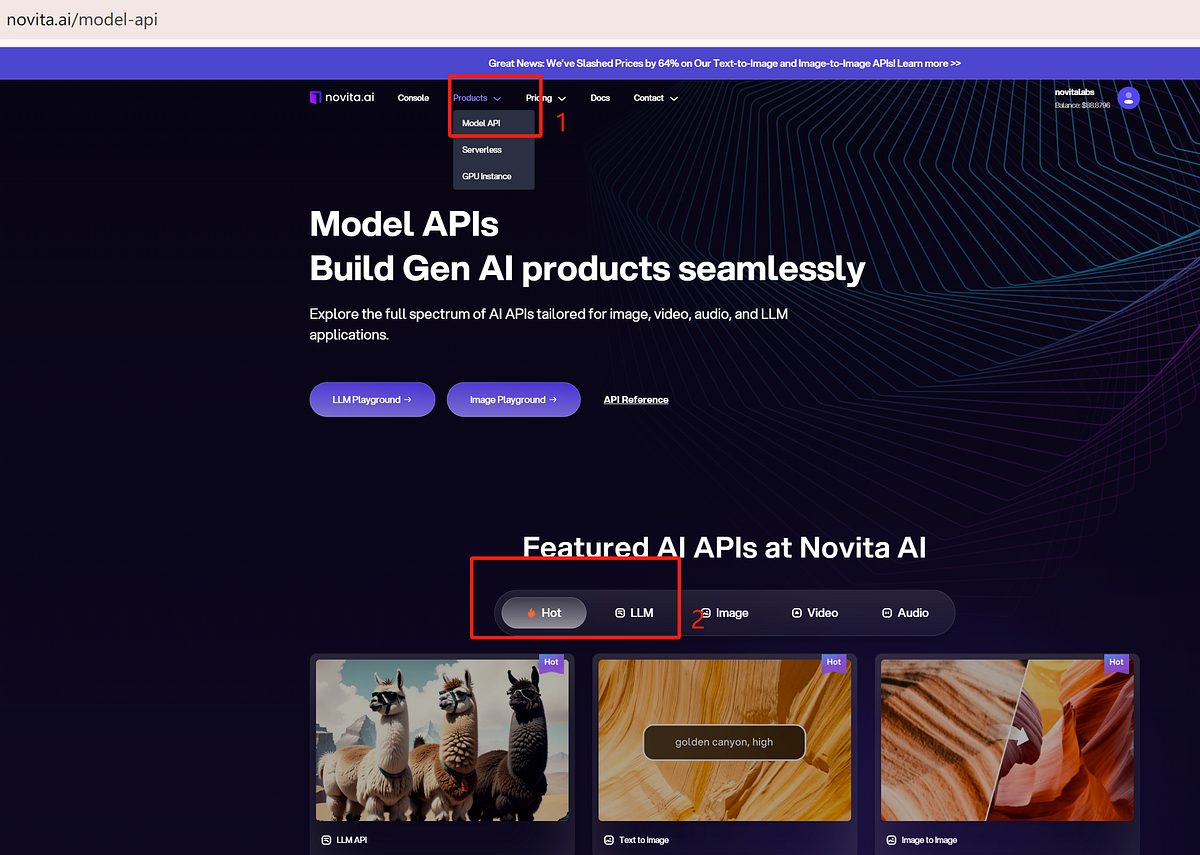
- Step 4: After entering the LLM service page, click “API Reference” to continue the following tasks.
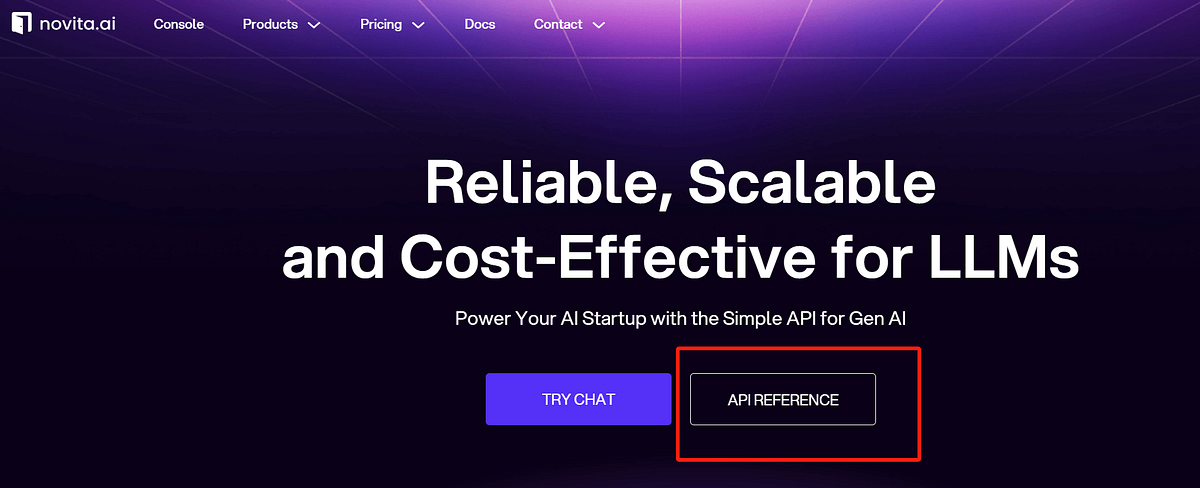
- Step 5: Go to the API and find the “LLM” in the “LLMs” section. Use your programming language’s package manager to install the Novita AI API.

- Step 6: Following installation, import the required libraries into your development environment. Begin interacting with Novita AI LLM by initializing the API with your API key.
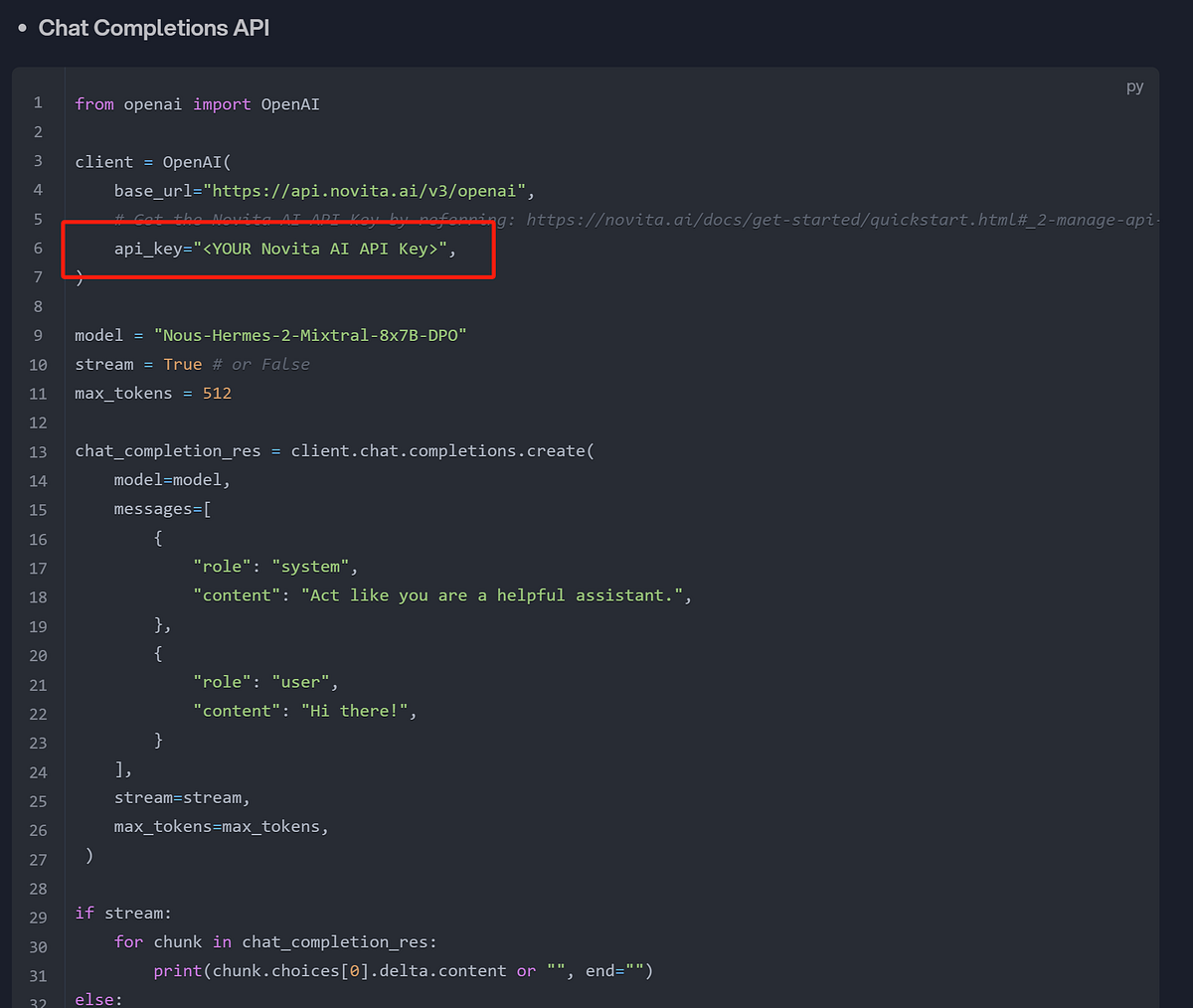
- Step 7: Adjust parameters including model, messages, prompt, max_tokens, and top_p to train models.

- Step 8: Test the new LLM API thoroughly before using it completely.
Sample Chat Completions API

Besides the LLM API service, you can also try LLMs for LLM services on the playground.
Try it on the playground.
- Step 1: Visit Novita AI and create an account.
- Step 2: Navigate to the “Products” tab and select Model API. Look for “Featured AI APIs” at Novita AI to find the LLM service in the first or second column.
- Step 3: Navigate to “Try Chat” to start trying.

- Step 4: Choose a model from the list. Customize settings such as temperature and max_tokens based on your requirements. Input a system prompt and click the right button for instant content.
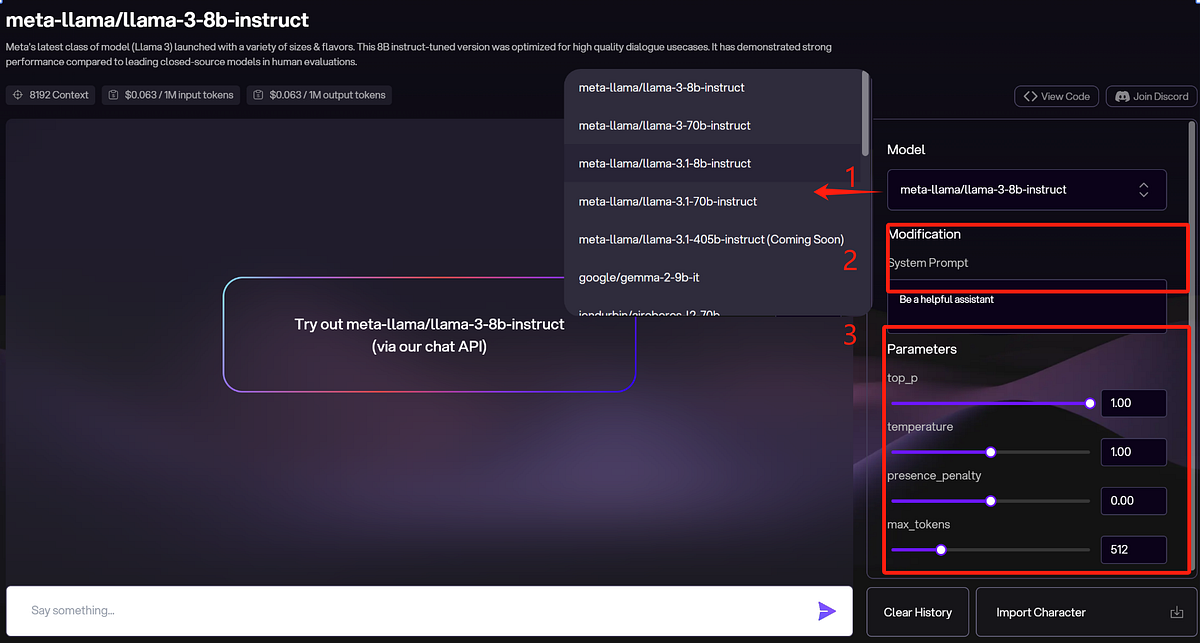
Tips for optimizing performance
- Keep users engaged: Creating a natural, friendly dialogue is essential for chatbot interactions. Timely and relevant responses help maintain smooth conversations and prevent confusion.
- Handling complex queries: Chatbots may struggle with complex queries, requiring a seamless transition to human agents. NLP identifies these challenges and involves human support.
Future Trends in Chatbot Development
Chatbots are evolving with AI and machine learning. Improved NLP helps chatbots understand users better for happier interactions. With voice assistants and VR in the mix, chatbots now seamlessly work across platforms. Embracing AI and new technologies keeps businesses at the forefront of chatbot development for advanced service.
Anticipating Changes in Customer Expectations
To maximize chatbot effectiveness, stay updated on customer expectations. AI-powered chatbots analyze user behaviour and feedback to improve responses over time. They can even initiate conversations based on user interactions, providing relevant information promptly for a better online experience. By staying attuned to evolving customer needs, businesses ensure their chatbots remain valuable tools for quick query resolution and exceptional service.
Gathering and Acting on User Feedback
Listening to user feedback is crucial for improving chatbots. It provides insights into what works well and what needs improvement. Surveys and chat analysis help identify issues. Acting on this feedback by updating responses, and knowledge base, or adding features enhances the chatbot experience over time, leading to smoother interactions.
Conclusion
Using chatbots effectively is crucial for successful automation. By offering reply choices, speaking plainly, and improving based on user input, you enhance the user experience. Chatbots revolutionize customer support by changing communication dynamics. Creating chatbots with a friendly tone and understanding natural language is key. Integrating chatbots seamlessly into the customer journey and refining conversations is essential. Stay updated on AI advancements and evolving user preferences. Embracing chatbots can streamline business operations significantly.
Frequently Asked Questions
How to make a chatbot more interactive?
Tailor responses based on user data and preferences. Introduce elements like quizzes, polls, or challenges to engage users and make the conversation fun.
What are some common pitfalls to avoid when setting up chatbot automation?
Over-personalizing interactions can make users uncomfortable. Balance personalization with privacy considerations. Designing overly complex dialogue trees can confuse users.
How can businesses ensure chatbots comply with data privacy regulations?
Collect the necessary data for the chatbot’s functionality. Avoid gathering excessive personal information. Use encryption to protect data both in transit and at rest.
Can chatbots be integrated with other platforms or systems for seamless automation?
Chatbots can work with other platforms like Customer Relationship Management (CRM) Systems, E-commerce platforms, payment gateways, and social media platforms (like Facebook Messenger or WhatsApp).
How long should a chatbot message be?
Aim for 1–2 sentences or around 20–40 words. Break longer information into smaller, digestible parts.
Novita AI is the All-in-one cloud platform that empowers your AI ambitions. Integrated APIs, serverless, GPU Instance — the cost-effective tools you need. Eliminate infrastructure, start free, and make your AI vision a reality.
Recommended Reading
1.AI Chatbot VS Traditional Chatbot: Unveiling Their Difference
2.LLMs And Chatbots: An Incomparable Match by Tech Manifest Destiny